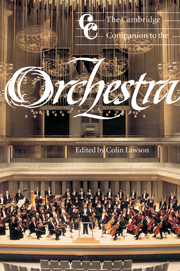Book contents
- Frontmatter
- 1 The history of the orchestra
- 2 The development of musical instruments: national trends and musical implications
- 3 The orchestral repertory
- 4 From notation to sound
- 5 The art of orchestration
- 6 The history of direction and conducting
- 7 International case studies
- 8 The revival of historical instruments
- 9 Recording the orchestra
- 10 Training the orchestral musician
- 11 The life of an orchestral musician
- 12 Historical recordings of orchestras
- 13 The orchestral composer
- 14 Educational programmes
- 15 The future of the orchestra
- Notes
- Appendices
6 - The history of direction and conducting
Published online by Cambridge University Press: 28 September 2011
- Frontmatter
- 1 The history of the orchestra
- 2 The development of musical instruments: national trends and musical implications
- 3 The orchestral repertory
- 4 From notation to sound
- 5 The art of orchestration
- 6 The history of direction and conducting
- 7 International case studies
- 8 The revival of historical instruments
- 9 Recording the orchestra
- 10 Training the orchestral musician
- 11 The life of an orchestral musician
- 12 Historical recordings of orchestras
- 13 The orchestral composer
- 14 Educational programmes
- 15 The future of the orchestra
- Notes
- Appendices
Summary
The mentality of the conductor is a dark, abysmal chapter in the history of music. His profession is by its very nature calculated to corrupt the character. When all is said and done, it is the only musical activity in which a dash of charlatanism is not only harmless but absolutely necessary.
carl fleschYou conductors, who are so proud of your powers! When a new man faces the orchestra – from the way he walks up the steps to the rostrum and opens his score – before he even picks up his baton – we know whether he is the master or we.
franz strauss (father of richard strauss)A conductor should reconcile himself to the realization that regardless of his approach or temperament the eventual result is the same – the orchestra will hate him.
oscar levantIntroduction
The conductor is many things to many people, now more than ever. Until well into the twentieth century, for instance, the profession, with few exceptions, was an exclusively male preserve. Today, women conductors, while still a minority, are increasingly familiar. Ethel Leginska (1886–1970) and Nadia Boulanger (1887–1979) were the great pioneers. Their successors include Veronika Dudarova, Iona Brown, Marin Alsop, Jane Glover, Odaline de la Martinez, Sian Edwards, Andrea Quinn and JoAnn Falletta, although at the time of writing, the principal conductors of all the world's major symphony orchestras remain resolutely male, and there is little evidence that this is likely to change in the immediately foreseeable future. And while the conductor still represents the very apex of glamour in the musical world, the profession itself has never been more seriously questioned.
- Type
- Chapter
- Information
- The Cambridge Companion to the Orchestra , pp. 112 - 125Publisher: Cambridge University PressPrint publication year: 2003



